Related Research Articles
Conn Cétchathach, or Conn of the Hundred Battles, son of Fedlimid Rechtmar, was a legendary High King of Ireland who is claimed to be the ancestor of the Connachta, and through his descendant Niall Noígiallach, the Uí Néill dynasties, which dominated Ireland in the early Middle Ages.

Crom Cruach was a pagan god of pre-Christian Ireland. According to Christian writers, he was propitiated with human sacrifice and his worship was ended by Saint Patrick.
The Culdees were members of ascetic Christian monastic and eremitical communities of Ireland, Scotland, Wales and England in the Middle Ages. Appearing first in Ireland and then in Scotland, subsequently attached to cathedral or collegiate churches; they lived in monastic fashion though not taking monastic vows.
Magh Slécht is the name of a historic plain in Ireland. It comprises an area of about three square miles (8 km2) situated in the south-eastern part of the Parish of Templeport, Barony of Tullyhaw, in the west of County Cavan. It is bounded on the south by Templeport Lough, on the north by Slieve Rushen mountain, on the east by the Shannon–Erne Waterway, and on the west by the River Blackwater. Magh Slécht formed part of the Province of Connacht until the late 16th century, when it was made part of the Province of Ulster by the English Crown.

Clogher is a village and civil parish in the border area of south County Tyrone, Northern Ireland. It lies on the River Blackwater, 5.8 miles from the border crossing to County Monaghan. It stands on the townlands of Clogher Demesne and Clogher Tenements. The 2011 Census recorded a population of 717. The civil parish of Clogher covers areas of County Fermanagh as well as County Tyrone.
Óengus mac Óengobann, better known as Saint Óengus of Tallaght or Óengus the Culdee, was an Irish bishop, reformer and writer, who flourished in the first quarter of the 9th century and is held to be the author of the Félire Óengusso and possibly the Martyrology of Tallaght.

The Bishop of Clogher is an episcopal title which takes its name after the village of Clogher in County Tyrone, Northern Ireland. Following the Reformation, there are now parallel apostolic successions: one of the Church of Ireland and the other of the Roman Catholic Church.
Saint Carthage the Elder was an Irish bishop and abbot in the sixth century. His feast day is 5 March.

Finnian of Movilla was an Irish Christian missionary. His feast day is 10 September.

Iarlaithe mac Loga, also known as Jarlath, was an Irish priest and scholar from Connacht, remembered as the founder of the monastic School of Tuam and of the Archdiocese of Tuam, of which he is the patron saint. No medieval biography of Jarlath is extant, but sources for his life and cult include genealogies, martyrologies, the Irish Lives of St Brendan of Clonfert, and a biography compiled by John Colgan in the 17th century.

Ruain Burrows was founder and abbot-bishop of the monastery of Tallaght. He is often considered to be a leading figure of the monastic 'movement' that has become known to scholarship as the Céli Dé. He is not to be confused with the later namesake Máel Ruain, bishop of Lusca.

Ciarán of Saigir, also known as Ciarán mac Luaigne or Saint Kieran, was one of the Twelve Apostles of Ireland and is considered the first saint to have been born in Ireland, although the legend that he preceded Saint Patrick is questionable. Ciarán was bishop of Saighir (Seir-Kieran) and remains the patron saint of its successor, the diocese of Ossory.

The Martyrology of Tallaght, which is closely related to the Félire Óengusso or Martyrology of Óengus the Culdee, is an eighth- or ninth-century Irish-language martyrology, a list of saints and their feast days assembled by Máel Ruain and/or Óengus the Culdee at Tallaght Monastery, near Dublin. The Martyrology of Tallaght is in prose and contains two sections for each day of the year, one general and one for Irish saints. It also has a prologue and an epilogue.
Saint Laisrén mac Nad Froích, or Laisrén of Devenish and Lasserian, known as Mo Laisse, was the patron saint of Devenish Island in Lough Erne, near Enniskillen, County Fermanagh, Ireland, in the present diocese of Clogher. Laisrén is the subject of both a Latin and an Irish Life, which offer loose narratives in which a number of miscellaneous anecdotes and miracles have been grouped together.
Crom Castle is a country house on the shores of Upper Lough Erne in County Fermanagh, Northern Ireland, the seat of the Earls Erne. Standing within the 1,900-acre (7.7 km2) Crom Estate, and within a formal garden, the castle is built in stone. A central battlemented tower includes the main entrance, and there are also smaller towers to one side. It stands apart from the ruins of Old Crom Castle, of which two towers, some walls, and a ha-ha survive, and near them two ancient yew trees, believed to be at least 800 years old.

Abbán of Corbmaic, also Eibbán or Moabba, was a saint and abbot. He is associated, first and foremost, with the Mag Arnaide. His order was, however, also connected to other churches elsewhere in Ireland, notably that of his alleged sister Gobnait.

St Macartin's Cathedral, Enniskillen, is one of two cathedral churches in the Diocese of Clogher in the Church of Ireland. It stands on high ground overlooking the town of Enniskillen, County Fermanagh, Northern Ireland in the ecclesiastical province of Armagh.

Saint Gobhan has long been linked with the parish of Seagoe – recorded for instance as Teach dho-Ghobha – in County Armagh, Ireland.

St. Scuithin also known as Scolan, Scothin or Scuitin, was a medieval Irish saint with strong Welsh connections. Sometime in the 6th century, Scuthin left Ireland to pursue a life of cenobitic monasticism at Tyddewi in Wales, founded by St. David.

The Tandragee Idol is the name given to a carved sandstone figure, generally dated to the Iron Age, with some sources suggesting a date as early as 1,000 BC. The sculpture was found in the 19th century in County Armagh, Northern Ireland. It is 60 cm (24 in) in height, and shows of the torso and head of a grotesque and brutish figure who crosses his body with his left arm to hold his right arm in what appears to be a ritualistic pose. The idol has a vulgar and gaping mouth, pierced nostrils and the stubs of what maybe the ends of a horned helmet.
References
- ↑ Oengus, the Culdee, Saint; Stokes, Whitley (1905). The Martyrology of Oengus the Culdee. London: Harrison and Sons. Retrieved 7 September 2020.
{{cite book}}: CS1 maint: multiple names: authors list (link) - ↑ "Zeitschrift für celtische Philologie".
- ↑ "Ogygia : Or, a chronological account of Irish events : Collected from very ancient documents, faithfully compared with each other, and supported by the genealogical and chronological aid of the sacred and prophane writings of the first nations of the globe". 1793.
- ↑ Nollaig O. Muraíle: 'Cathal Óg Mac Maghnusa: His Time, Life and Legacy' in Clogher Record, Vol. 16, No. 2 (1998), p. 59
- ↑ Nicholls, K. W., 'The Register of Clogher' in Clogher Record, Vol. 7, No. 3 (1971/1972), ff. 21v.-22r., pp. 400-403
- ↑ Hayes, E.; Kenealy, W. (1857). The Ballads of Ireland. Vol. 2. A. Fullarton & Company. p. 170. Retrieved 6 August 2015.
- ↑ "Part 101 of the Metrical Dindshenchas".
- ↑ "Cath Maighe Léna".
2. "The So-Called Cloch Oir at Clogher Cathedral", by H. C. Lawlor in the Irish Naturalists' Journal Vol. 3, No. 9, May, 1931, p. 193. (viewable on JSTOR)